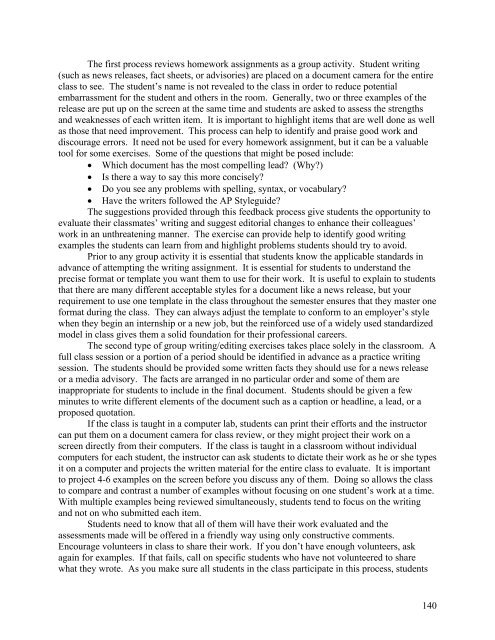2008 PROCEEDINGS - Public Relations Society of America
2008 PROCEEDINGS - Public Relations Society of America
2008 PROCEEDINGS - Public Relations Society of America
You also want an ePaper? Increase the reach of your titles
YUMPU automatically turns print PDFs into web optimized ePapers that Google loves.
The first process reviews homework assignments as a group activity. Student writing<br />
(such as news releases, fact sheets, or advisories) are placed on a document camera for the entire<br />
class to see. The student’s name is not revealed to the class in order to reduce potential<br />
embarrassment for the student and others in the room. Generally, two or three examples <strong>of</strong> the<br />
release are put up on the screen at the same time and students are asked to assess the strengths<br />
and weaknesses <strong>of</strong> each written item. It is important to highlight items that are well done as well<br />
as those that need improvement. This process can help to identify and praise good work and<br />
discourage errors. It need not be used for every homework assignment, but it can be a valuable<br />
tool for some exercises. Some <strong>of</strong> the questions that might be posed include:<br />
• Which document has the most compelling lead? (Why?)<br />
• Is there a way to say this more concisely?<br />
• Do you see any problems with spelling, syntax, or vocabulary?<br />
• Have the writers followed the AP Styleguide?<br />
The suggestions provided through this feedback process give students the opportunity to<br />
evaluate their classmates’ writing and suggest editorial changes to enhance their colleagues’<br />
work in an unthreatening manner. The exercise can provide help to identify good writing<br />
examples the students can learn from and highlight problems students should try to avoid.<br />
Prior to any group activity it is essential that students know the applicable standards in<br />
advance <strong>of</strong> attempting the writing assignment. It is essential for students to understand the<br />
precise format or template you want them to use for their work. It is useful to explain to students<br />
that there are many different acceptable styles for a document like a news release, but your<br />
requirement to use one template in the class throughout the semester ensures that they master one<br />
format during the class. They can always adjust the template to conform to an employer’s style<br />
when they begin an internship or a new job, but the reinforced use <strong>of</strong> a widely used standardized<br />
model in class gives them a solid foundation for their pr<strong>of</strong>essional careers.<br />
The second type <strong>of</strong> group writing/editing exercises takes place solely in the classroom. A<br />
full class session or a portion <strong>of</strong> a period should be identified in advance as a practice writing<br />
session. The students should be provided some written facts they should use for a news release<br />
or a media advisory. The facts are arranged in no particular order and some <strong>of</strong> them are<br />
inappropriate for students to include in the final document. Students should be given a few<br />
minutes to write different elements <strong>of</strong> the document such as a caption or headline, a lead, or a<br />
proposed quotation.<br />
If the class is taught in a computer lab, students can print their efforts and the instructor<br />
can put them on a document camera for class review, or they might project their work on a<br />
screen directly from their computers. If the class is taught in a classroom without individual<br />
computers for each student, the instructor can ask students to dictate their work as he or she types<br />
it on a computer and projects the written material for the entire class to evaluate. It is important<br />
to project 4-6 examples on the screen before you discuss any <strong>of</strong> them. Doing so allows the class<br />
to compare and contrast a number <strong>of</strong> examples without focusing on one student’s work at a time.<br />
With multiple examples being reviewed simultaneously, students tend to focus on the writing<br />
and not on who submitted each item.<br />
Students need to know that all <strong>of</strong> them will have their work evaluated and the<br />
assessments made will be <strong>of</strong>fered in a friendly way using only constructive comments.<br />
Encourage volunteers in class to share their work. If you don’t have enough volunteers, ask<br />
again for examples. If that fails, call on specific students who have not volunteered to share<br />
what they wrote. As you make sure all students in the class participate in this process, students<br />
140
















